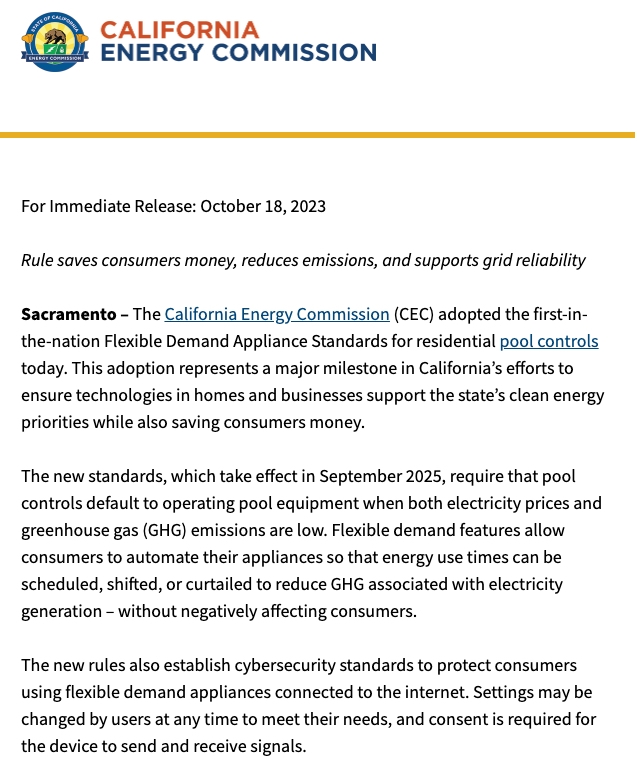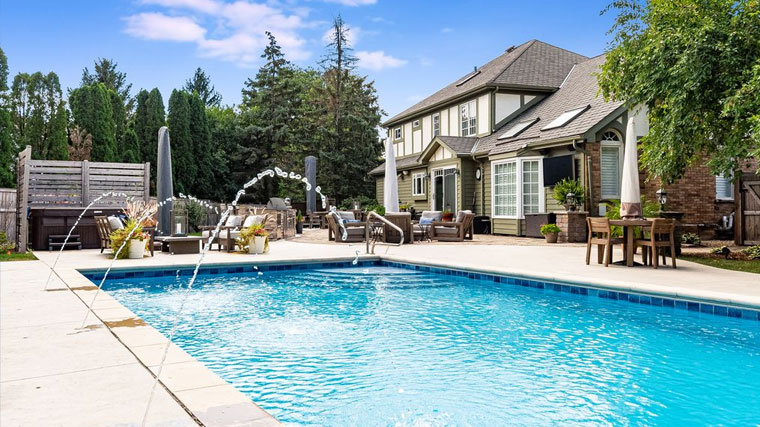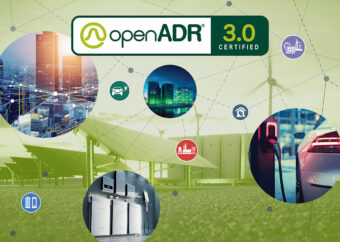SB 49: Demand Flexibility for Pool Pumps — Deadline Approaching
Only months remain until the September 2025 compliance deadline. By then, new CA regulations require pool pumps and related equipment to shift energy usage to cheaper, cleaner periods.
Most OEMs need 4+ months of development to ensure compliance—so the time to act is now. Explore how Codibly can help you avoid missed deadlines and gain a competitive edge with advanced demand response solutions.
Secure your spot in our fast-track program or submit your interest below.

What is SB 49?
California has long led the way on energy efficiency, and Senate Bill 49 is the latest effort to modernize the grid through demand flexibility.
By September 2025, pool pumps, controls, and related equipment sold in the state must support smart energy shifting—operating during off-peak times when electricity is cleaner and more affordable.
For OEMs, this is more than just compliance—it’s a chance to future-proof products and open doors to new revenue models. By integrating technologies like OpenADR or CTA-2045, pool systems can automatically respond to grid signals, saving consumers money while reducing peak load and emissions.
Important Note: With only a few months left, and ~4 months of engineering typically required, you’ll need to start compliance efforts immediately.
Video Source: CalEnergyCommission YouTube
Meeting SB 49 With Codibly
Key Ways We Help Manufacturers Adapt to SB 49
Codibly’s combination of consulting, pre-built accelerators, and certification support ensures you can comply with SB 49—while adding tangible value to your products. Act now to secure a compliance start date that guarantees a timely launch.
Consulting & Training
Guidance on SB 49 requirements, adopting OpenADR or CTA-2045, and building a roadmap to finish within 4 months.
Pre-Built Accelerators
Accelerated integrations of OpenADR or CTA-2045, cutting dev time by up to 70%—ensuring compliance before September.
Certification Support
We’ll ensure your pool pump solutions meet California’s flexible demand appliance standards and pass compliance testing on time.
Industry Expertise
We’re a recognized OpenADR Alliance partner, with proven DR experience for consumer appliances—start now, avoid last-minute bottlenecks.
HOW TO ADAPT SOFTWARE FOR DEMAND FLEXIBILITY FOR SB 49
Key Technical Steps for Pool Pump OEMs to Meet the Deadline
Load Modeling & 8,760-Hour Data: Pool OEMs must implement granular, hour-by-hour load simulations. This includes factoring in TOU rates, greenhouse gas forecasts, and aggregator price signals—often pulled from the CEC’s Midas server. Accurate data modeling ensures you can effectively shift pump usage to off-peak or cleaner hours before the September deadline.
OpenADR/CTA-2045 Integrations: Embed protocol handlers that authenticate securely with aggregators (VTN). Software should parse incoming DR events (peak alerts, price signals) and automatically adjust pump operation schedules. Starting this 4-month integration soon is crucial for meeting SB 49.
Default Scheduling & Security: Implement a mandatory default schedule (e.g., 9 AM–3 PM) aligned with midday solar. Allow homeowner overrides and event-based pausing if the grid signals a shortage. Enforce unique device IDs, user consent controls, and secure firmware updates to maintain compliance and protect consumer data in time.
Certification & Implementation Roadmap: Complete OpenADR or CTA-2045 certification, then register products in the CEC Appliance Database. Validate scheduling logic in test labs, ensure aggregator event logging, and maintain an agile update process for new FDAS expansions (e.g., water heaters, battery storage). Remember the ~4-month lead time.
Technical Software Solutions for Demand Flexibility in Pool Pumps
Implementing demand flexibility for residential pool pumps under California’s SB 49 (and similar regulations) requires precise, robust software strategies. Below are the key steps and considerations for OEMs, aggregators, and solution providers building DR (Demand Response) capabilities into pool equipment. Remember, each step needs adequate time—don’t risk starting too late.
1. Load Modeling & 8,760-Hour Data
To shift pool pump operation to lower-emission or off-peak periods, developers must build hourly or sub-hourly load models that:
- Reference 8,760-hour datasets for seasonal/intraday patterns—simulate typical grid conditions.
- Incorporate TOU (Time-of-Use) rates, real-time signals, or GHG emission forecasts (e.g., via the CEC’s Midas server).
2. Communications & Protocol Integration
Most DR aggregations rely on OpenADR 2.0/3.0 or CTA-2045 protocols to receive event signals and dispatch load shifts. Key software components include:
- VEN/VTN Architecture: If using OpenADR, your pool controller (VEN) must authenticate with a DR aggregator’s VTN—listening for price or load-shed events.
- CTA-2045 Module Integration: Attach a CTA-2045 communication module for utility/aggregator signals (price, flex alerts).
- Real-Time or Day-Ahead Scheduling: “Avoid 4-9 PM peak” or “Run midday” logic. Implementation done via default schedules that adapt to aggregator events.
3. Default Scheduling & Consumer Overrides
California’s FDAS mandate a default operational schedule for low-emission or off-peak hours. Software should:
- Provide a fallback schedule (e.g., 9 AM–3 PM) if aggregator signals are absent.
- Allow local overrides for usage/maintenance, without forfeiting DR capabilities.
- Handle event-based pausing (e.g., “flex alert”) to reduce consumption during urgent grid constraints.
4. Aggregator & Utility Coordination
To fully participate in DR programs, the pool pump software stack should:
- Synchronize with aggregator APIs securely. Only authorized signals can control the pump.
- Implement robust scheduling logic merging aggregator requests with local user preferences.
- Support event logging & audits for compliance and certification proof.
5. Data Security & Consumer Consent
SB 49 and FDAS rules require strict cybersecurity. Software must:
- Use device-level unique IDs for targeted vulnerability patches.
- Enforce strong authentication (password complexity, certificates) for remote updates.
- Store consumer consent locally/cloud for opt in/out of DR/data sharing.
- Enable automatic firmware updates with secure, signed packages.
6. Compliance & Certification Path
Manufacturers must demonstrate compliance with FDAS, including:
- OpenADR/CTA-2045 Certification: Test software in recognized labs/harnesses before market release.
- CEC Appliance Database Registration: Document functional/security aspects prior to CA shipping.
- Ongoing Regulatory Updates: Track new FDAS expansions or load-management standards requiring advanced automation (GHG signals, etc.).
7. Implementation Roadmap
OEMs or integrators should plan a multi-phase approach:
- Firmware Upgrade: Add comms (Wi-Fi, cellular, CTA-2045), scheduling logic, overrides, security.
- Cloud/Backend Integration: Build aggregator microservices, user portals, real-time DR signal handling.
- Testing & Certification: Validate aggregator compatibility via official labs (OpenADR Alliance, etc.).
- Deployment & Maintenance: Roll out firmware, patch security holes, track FDAS expansions.
By architecting for load shifting from the ground up, OEMs transform pool equipment into a grid asset—lowering emissions, reducing bills, and meeting SB 49 on time.

Codibly OpenADR Accelerators
Our pre-built microservices drastically reduce your time to market, letting you focus on unique pump features rather than boilerplate protocol logic. Quickly achieve OpenADR 2.0b/3.0 VEN compliance, with a streamlined licensing model for faster, more affordable deployment.
- Flexible License: One-time fee, perpetual usage & modification rights
- Certified OpenADR Product: Save time & money on repeated certifications
- Rapid Integration: Implementation can be done in weeks
- Transferable Certification: Straightforward compliance for you & your end-users
- Time & Budget Optimization: Focus on unique features—our accelerator handles standard protocol logic
Start integration ASAP to ensure you meet the 4-month dev window!
What the OpenADR Alliance Says
Webinar: Flexible Demand Appliance Standards for Pool Controls
Shifting Pool Equipment Loads to Cut Costs & Emissions
Watch the webinar where the California Energy Commission (CEC) showcases its first-in-the-world Flexible Demand Appliance Standards (FDAS) for residential swimming pool controls.
The session highlights how flexible demand technologies allow appliances to shift or curtail power usage with consumer consent. The newly adopted standard, mandatory by September 2025, forms a foundation for further load management initiatives—covering other technologies like electric water heaters, air source heat pumps, and battery storage.
CONTACT US
Ready to Secure Your SB 49 Compliance?
- 4-Month Dev Timeline: Start now to meet the September deadline
- Fast Compliance Roadmap: 15-min call + custom approach
- Full Integration: Firmware, aggregator services, certification













